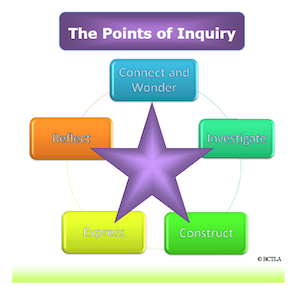 Yesterday felt wonderful, like fresh air breathed straight to the brain. I believe this is because my small group was fully engaged in the “connect and wonder” stage, or “tuning in” stage. This is where passion and percolating questions flow freely. Today, at the outset of our class, we as a group realized that we have started to investigate, gathering research links like a jackdaw, but we have now very clearly stalled. We need to construct, to process, venturing as individual entities, and sync our understandings for a greater composite unity. We are still making meaning for ourselves, yet it is through the continual praxial process of wonder, investigate, construct, express, share, reflect, and repeat (, and repeat, and ….) that meaning is made individually and collectively. One of the most harrowing struggles within the education system is the lack of this time, this process for inquiry, composite unity and individual meaning making as we have experienced in two short days. I believe inquiry and collaboration time/processes could have the most profound impact on the system, teacher practice and all participants’ learning, more so than another projector or cart of ipads.
Yesterday felt wonderful, like fresh air breathed straight to the brain. I believe this is because my small group was fully engaged in the “connect and wonder” stage, or “tuning in” stage. This is where passion and percolating questions flow freely. Today, at the outset of our class, we as a group realized that we have started to investigate, gathering research links like a jackdaw, but we have now very clearly stalled. We need to construct, to process, venturing as individual entities, and sync our understandings for a greater composite unity. We are still making meaning for ourselves, yet it is through the continual praxial process of wonder, investigate, construct, express, share, reflect, and repeat (, and repeat, and ….) that meaning is made individually and collectively. One of the most harrowing struggles within the education system is the lack of this time, this process for inquiry, composite unity and individual meaning making as we have experienced in two short days. I believe inquiry and collaboration time/processes could have the most profound impact on the system, teacher practice and all participants’ learning, more so than another projector or cart of ipads.
Today’s lecture and corresponding forum discussion articulated what I have struggled with throughout this course: my frustration at the disconnect between needed change, and the system’s inability or superficial misguided practices of change. Dynamic conservativism, besides being a delightful oxymoron, is slowly being recognized in my school. Many colleagues in the Socials department fell into the trap of “powerpoint karaoke,” simply administering a traditional history lecture but attending to their visual learner needs by having it displayed. Teacher was still the provider of knowledge and student the recipient. Recently, our school Professional Learning Committee, which occurs informally every Friday morning, has been burgeoning with teachers looking to collaborate and re-create their practice beyond “powerpoint karaoke.”
Furthermore, our discussion of sociocultural homeostasis peeked my conception of educator responsibility. We clearly have a significant responsibility to facilitate students’ learning in all modes, of all literacies (digital, critical, print, visual, and aural and many more), yet this day’s discussion brought up the issue of sociocultural literacy and practice, of our students’ necessary EQ. According to Forbes it is not only our students’ ability to “know” and think, or their IQ, that must be nurtured. It is equally, if not more important that students be able to read people, connect, communicate, empathize and be self-confident. This is what our students need from us, and yet the sociocultural environment hinders necessary change to allow for growth of practice, and as such, we all lose out. Another interesting factor is that our unique sociocultural environment hinders change. Yet, in many ways the digital world confounds and subverts any traditional boundaries. It’s hard to keep out. As such, I would like to continue to explore (with my inquiry group) how social media can act as a tool for change, within sociocultural environments as fixed as our current education system. I would also like to add the inspirational clip from the slums of Brazil and India. Here Charles Leadbeater shows that educational innovation is possible anywhere:


